Belgrade - The fortress on the river mouth of Sava - Danube
- Written by Portal Editor
After our extensive city tour through the center of Belgrade in the impressive Cabriolet of Ducan we had agreed to explore the Castle ourselves and then go back to the Camper Stop Station 38 - Camping Center Belgrade.
Of course, we also wanted to determine the exact distance on foot, after we had also pointed out the bus line 35 from the city center back to the camper stop. To anticipate it from the castle back to the camper stop, it is exactly 5.3 kilometers, which have to be completed on partially busy streets. Once again we used the map system of google maps.
Above Sava River delta into the Danube
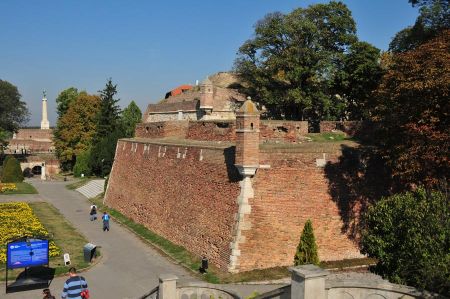 The fortress of Belgrade is the climax and the historical core of the Serbian capital Belgrade. It dates back to the beginning of the fifteenth century, but was expanded by modern bastions in the late 17th century and early 18th century.
The fortress of Belgrade is the climax and the historical core of the Serbian capital Belgrade. It dates back to the beginning of the fifteenth century, but was expanded by modern bastions in the late 17th century and early 18th century.
The central fortress of Belgrade was fiercely contested during the military confrontation about the predominance in Central Eastern Europe between the great powers of the Habsburg monarchy and the Ottoman Empire in the Turkish wars, and was briefly held by Austria in the 17th and 18th centuries. In the course of the First Serbian uprising against the Turks, the Serbs conquered the fortress in 1807, which retained however an Ottoman commander until 1867.
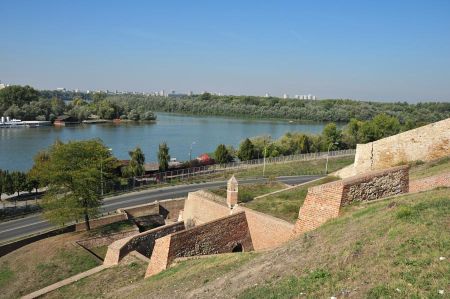 Strategically located on a 50 meter high lime spur above the river delta of the Save into the Danube, the fortress today is also the landmark of the city. Beside ramparts, bastions, towers and gates the numerous monuments as well as two churches and the Military History Museum of Serbia tourist are the main attractions in the complex. In the former ramparts of the fortress the Great and the Small Kalemegdan are arranged as generous parks and the Zoo of Belgrade. The name Kalemegdan is taken from the Turkish "Kale meydanı" and refers to the great free space around the citadel which forms the core of the fortress. The open air was built in the course of the 1880s, when the terrain was transformed into a large park. The first design of this park was made by order of Prince Mihailo Obrenović from the first Belgrade town builder Emilijan Josimović.
Strategically located on a 50 meter high lime spur above the river delta of the Save into the Danube, the fortress today is also the landmark of the city. Beside ramparts, bastions, towers and gates the numerous monuments as well as two churches and the Military History Museum of Serbia tourist are the main attractions in the complex. In the former ramparts of the fortress the Great and the Small Kalemegdan are arranged as generous parks and the Zoo of Belgrade. The name Kalemegdan is taken from the Turkish "Kale meydanı" and refers to the great free space around the citadel which forms the core of the fortress. The open air was built in the course of the 1880s, when the terrain was transformed into a large park. The first design of this park was made by order of Prince Mihailo Obrenović from the first Belgrade town builder Emilijan Josimović.
The plateau of the former Roman castrum
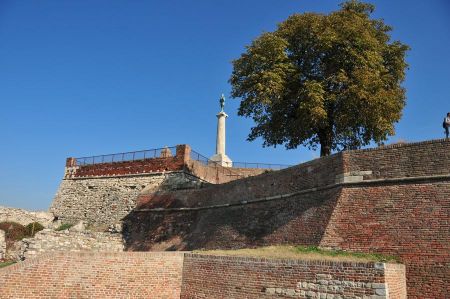 The fortress is situated above the mouth of the river Save in the Danube and is divided into the upper town or upper castle lying on the limestone plateau and the lower town or lower castle lying in the Alluvial plain. From the upper town terrace you can see the rivers of the river Save and the Danube, the Great War Island (Veliko ratno ostrovo), and the Belgrade districts of Zemun and Novi Beograd. Towards the north are the flat monolithic lowlands of the Pannonian lowlands. To the south the strongholds of the Šumadija stretches from the fortress. The upper and lower parts are connected by a single gate.
The fortress is situated above the mouth of the river Save in the Danube and is divided into the upper town or upper castle lying on the limestone plateau and the lower town or lower castle lying in the Alluvial plain. From the upper town terrace you can see the rivers of the river Save and the Danube, the Great War Island (Veliko ratno ostrovo), and the Belgrade districts of Zemun and Novi Beograd. Towards the north are the flat monolithic lowlands of the Pannonian lowlands. To the south the strongholds of the Šumadija stretches from the fortress. The upper and lower parts are connected by a single gate.
In the medieval heyday at the beginning of the 15th century the residence of the despot Stefan Lazarević was located in the upper town. The suburb accommodated the residential center, the religious institutions with the Franciscan monastery and the Orthodox city cathedral, the Belgrade Mitropolija. A Danube port had existed since the beginning of the fifteenth century, a Save harbor already under King Stefan Uroš II Milutin, who had erected the Save settlement.
Belgrade – The strategic importance of the fortress
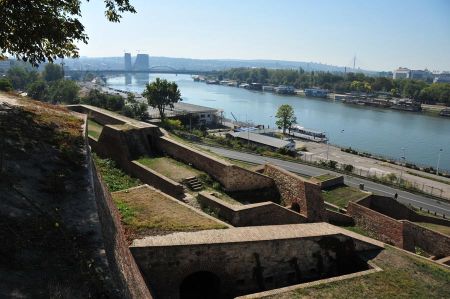 The fortress consists of two parts: the upper town, which occupies the plateau of the former Roman Castrum (to which we shall reflect later), Byzantine fortresses and the city of the Despot, as well as the suburbs. The late medieval core of the upper town was fortified in the Baroque to the south and east by bastions. The subdivision is divided into the western part of the town and the artillery bastions in the east, built in the 13th and 14th century by King Stefan Uroš II Milutin on the banks of the river, the suburb of the despot from the beginning of the 15th century.
The fortress consists of two parts: the upper town, which occupies the plateau of the former Roman Castrum (to which we shall reflect later), Byzantine fortresses and the city of the Despot, as well as the suburbs. The late medieval core of the upper town was fortified in the Baroque to the south and east by bastions. The subdivision is divided into the western part of the town and the artillery bastions in the east, built in the 13th and 14th century by King Stefan Uroš II Milutin on the banks of the river, the suburb of the despot from the beginning of the 15th century.
The once towering upper town changed its appearance particularly in the 17th to the 18th century when the towers designed for blank weapons became obsolete and reinforced bastions were built for guns. The former castle of the despot Stefan Lazarević in the upper town was destroyed during the conquest of Belgrade in 1688.
Belgrade – The Strategic Importance of the Fortress - more details
Belgrade, the capital of Serbia, looks back on a turbulent history. The city is located at a strategically important point where the Danube and Sava rivers meet – a location that made it a contested area for centuries. At the centre of this history is the imposing Belgrade Fortress, which played a crucial role as a defensive structure, seat of power, and symbol of the city. Today, it is not only a historical monument, but also a popular tourist attraction and cultural centre.
The Belgrade Fortress – A Historical Landmark
Location and Architectural Features
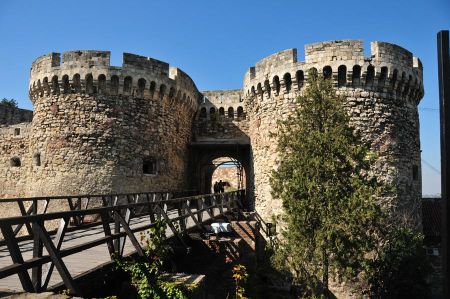 The Belgrade Fortress sits perched on a hill above the confluence of the Sava and Danube rivers. It consists of two main areas: the Upper Town (Gornji Grad), which once served as a military base, and the Lower Town (Donji Grad), which housed commercial and residential districts.
The Belgrade Fortress sits perched on a hill above the confluence of the Sava and Danube rivers. It consists of two main areas: the Upper Town (Gornji Grad), which once served as a military base, and the Lower Town (Donji Grad), which housed commercial and residential districts.
The Importance of the Fortress for Urban Development
For centuries, the fortress was the focal point of the city. It served not only as a defensive wall against enemy attacks, but also as a political and cultural center that significantly influenced Belgrade's growth and development.
The Fortress's Strategic Role Throughout the Centuries
Ottoman Rule and Its Impact
In the 16th century, Belgrade fell into the hands of the Ottoman Empire. The fortress became a key position for control over the Balkans. During this time, it was repeatedly expanded and reinforced to withstand attacks from the West.
The Habsburgs and the Wars of Liberation
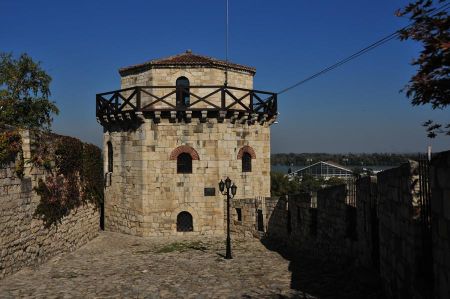 In the 18th century, the Habsburgs fought against the Ottomans and temporarily conquered the fortress. This period brought significant structural changes, including the construction of new defences’ based on European models.
In the 18th century, the Habsburgs fought against the Ottomans and temporarily conquered the fortress. This period brought significant structural changes, including the construction of new defences’ based on European models.
The Role in World Wars I and II
During the World Wars, the fortress was a strategically important point that was repeatedly fought over. After World War II, it was finally converted into a public park and cultural center.
The Fortress Today – A Living Monument
Sights within the Fortress Walls
Today, the Belgrade Fortress is one of the city's most important tourist attractions. Highlights include:
• St. Petka Chapel: A small Orthodox church with a beautiful interior.
• The Pobednik Monument: A statue commemorating Serbia's victory in World War I.
• The fortress walls and towers: They offer breathtaking views of the city and the rivers.
Museums and Cultural Attractions
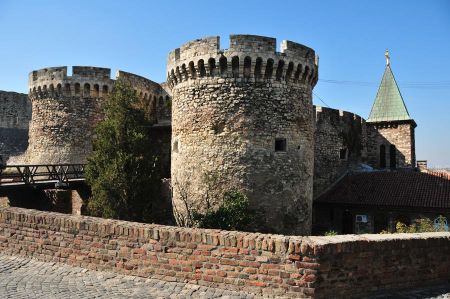 Within the fortress are several museums, including the Military Museum, which offers an in-depth look at Serbia's military history.
Within the fortress are several museums, including the Military Museum, which offers an in-depth look at Serbia's military history.
Kalemegdan Park – The Green Heart of Belgrade
History and Significance of the Park
Kalemegdan Park surrounds the fortress and is one of the most beautiful places in Belgrade. Originally used as a military area, it was later converted into a public park.
Leisure and Recreational Opportunities
Today, the park serves as a popular meeting place for locals and tourists. Here, you can stroll, enjoy the impressive views, or relax in one of the many cafés.
Secrets and Legends of the Fortress
The Underground Passages and Mysterious Stories
Beneath the fortress lies a network of secret tunnels that has not yet been fully explored. Some stories tell of hidden treasure chambers and underground escape routes.
The Legend of the Roman Well
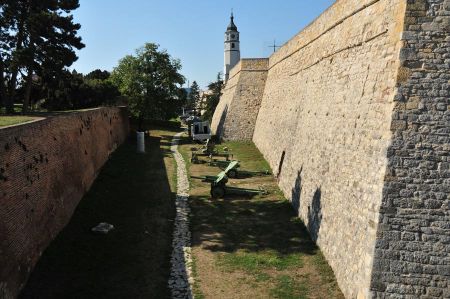 The so-called Roman Well within the fortress is said to be immeasurably deep. According to legend, prisoners were once thrown into it – a dark chapter in history.
The so-called Roman Well within the fortress is said to be immeasurably deep. According to legend, prisoners were once thrown into it – a dark chapter in history.
The Fortress at Night – An Unforgettable Experience
Panoramic View of the Danube and Sava Rivers
At night, the fortress transforms into a romantic setting. The city lights reflect in the water, while the illuminated walls create a mystical atmosphere.
Light installations and night tours
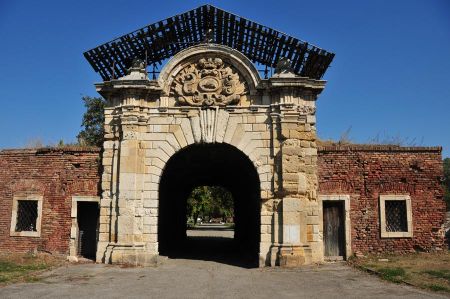 The guided night walks are particularly charming, offering fascinating stories and anecdotes about the fortress.
The guided night walks are particularly charming, offering fascinating stories and anecdotes about the fortress.
Best time to visit and tips for visitors
When to visit the fortress?
The best time to visit is spring or fall, when the weather is pleasant and crowds are thinner.
Important travel tips for a successful experience
- Wear comfortable shoes – some of the paths are uneven.
- Allow enough time – there's a lot to explore!
- Use safe viewing points – some areas have no railings.
Conclusion
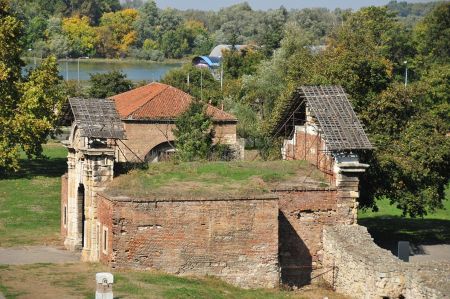 The Belgrade Fortress is more than just a historical monument – it is the heart of the city and tells the story of Serbia in a striking way. Visitors to Belgrade should take the time to explore this impressive landmark and enjoy the unique atmosphere.
The Belgrade Fortress is more than just a historical monument – it is the heart of the city and tells the story of Serbia in a striking way. Visitors to Belgrade should take the time to explore this impressive landmark and enjoy the unique atmosphere.
Frequently Asked Questions (FAQs)
1. Is admission to the Belgrade Fortress free?
Yes, admission is free, but some museums within the fortress charge a small fee.
2. Are there guided tours of the fortress?
Yes, there are numerous providers of historical and themed tours.
3. Can you buy food and drinks inside the fortress?
Yes, there are cafes and restaurants with great views.
4. Is the fortress child-friendly?
Yes, but parents should be aware of unsecured areas.
5. How much time should you plan for the visit?
At least 2–3 hours to explore at your leisure.
Please read as well:
Tolerance - exhibition of paintings in Belgrade Castle
Camping Club Serbia - Danube-Meeting Smeterova
-
 Belgrade Castle Sightseeing Tour
Belgrade Castle Sightseeing Tour
Belgrade Castle Sightseeing Tour
Belgrade Castle Sightseeing Tour
-
 Belgrade Castle Sightseeing Tour
Belgrade Castle Sightseeing Tour
Belgrade Castle Sightseeing Tour
Belgrade Castle Sightseeing Tour
-
 Belgrade Castle Sightseeing Tour
Belgrade Castle Sightseeing Tour
Belgrade Castle Sightseeing Tour
Belgrade Castle Sightseeing Tour
-
 Belgrade Castle Sightseeing Tour
Belgrade Castle Sightseeing Tour
Belgrade Castle Sightseeing Tour
Belgrade Castle Sightseeing Tour
-
 Belgrade Castle Sightseeing Tour
Belgrade Castle Sightseeing Tour
Belgrade Castle Sightseeing Tour
Belgrade Castle Sightseeing Tour
-
 Belgrade Castle Sightseeing Tour
Belgrade Castle Sightseeing Tour
Belgrade Castle Sightseeing Tour
Belgrade Castle Sightseeing Tour
-
 Belgrade Castle Sightseeing Tour
Belgrade Castle Sightseeing Tour
Belgrade Castle Sightseeing Tour
Belgrade Castle Sightseeing Tour
-
 Belgrade Castle Sightseeing Tour
Belgrade Castle Sightseeing Tour
Belgrade Castle Sightseeing Tour
Belgrade Castle Sightseeing Tour
-
 Belgrade Castle Sightseeing Tour
Belgrade Castle Sightseeing Tour
Belgrade Castle Sightseeing Tour
Belgrade Castle Sightseeing Tour
-
 Belgrade Castle Sightseeing Tour
Belgrade Castle Sightseeing Tour
Belgrade Castle Sightseeing Tour
Belgrade Castle Sightseeing Tour
-
 Belgrade Castle Sightseeing Tour
Belgrade Castle Sightseeing Tour
Belgrade Castle Sightseeing Tour
Belgrade Castle Sightseeing Tour
-
 Belgrade Castle Sightseeing Tour
Belgrade Castle Sightseeing Tour
Belgrade Castle Sightseeing Tour
Belgrade Castle Sightseeing Tour
-
 Belgrade Castle Sightseeing Tour
Belgrade Castle Sightseeing Tour
Belgrade Castle Sightseeing Tour
Belgrade Castle Sightseeing Tour
-
 Belgrade Castle Sightseeing Tour
Belgrade Castle Sightseeing Tour
Belgrade Castle Sightseeing Tour
Belgrade Castle Sightseeing Tour
-
 Belgrade Castle Sightseeing Tour
Belgrade Castle Sightseeing Tour
Belgrade Castle Sightseeing Tour
Belgrade Castle Sightseeing Tour
-
 Belgrade Castle Sightseeing Tour
Belgrade Castle Sightseeing Tour
Belgrade Castle Sightseeing Tour
Belgrade Castle Sightseeing Tour
-
 Belgrade Castle Sightseeing Tour
Belgrade Castle Sightseeing Tour
Belgrade Castle Sightseeing Tour
Belgrade Castle Sightseeing Tour
-
 Belgrade Castle Sightseeing Tour
Belgrade Castle Sightseeing Tour
Belgrade Castle Sightseeing Tour
Belgrade Castle Sightseeing Tour
-
 Belgrade Castle Sightseeing Tour
Belgrade Castle Sightseeing Tour
Belgrade Castle Sightseeing Tour
Belgrade Castle Sightseeing Tour
-
 Belgrade Castle Sightseeing Tour
Belgrade Castle Sightseeing Tour
Belgrade Castle Sightseeing Tour
Belgrade Castle Sightseeing Tour
-
 Belgrade Castle Sightseeing Tour
Belgrade Castle Sightseeing Tour
Belgrade Castle Sightseeing Tour
Belgrade Castle Sightseeing Tour
